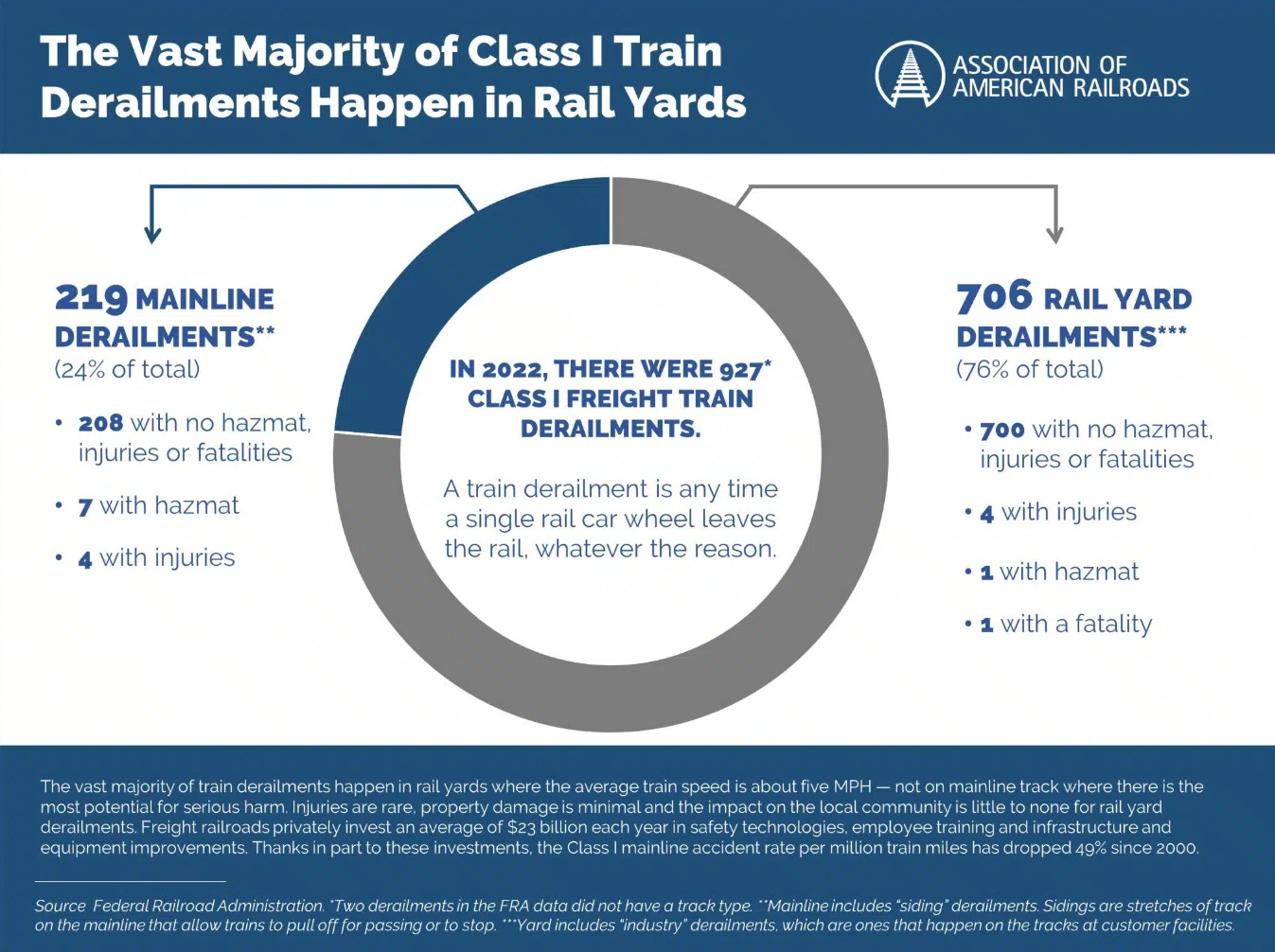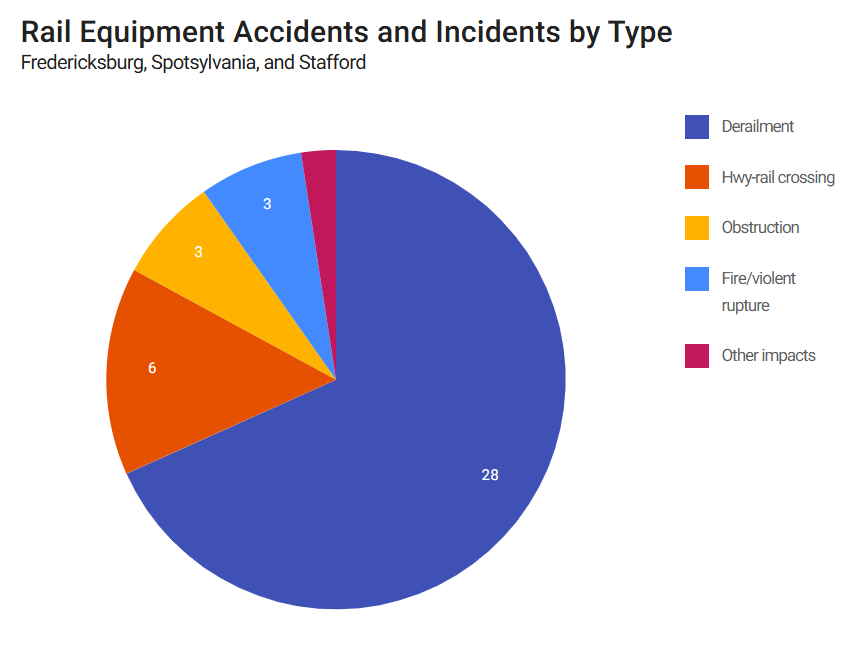
About three trains a day derail in the U.S., most at low speed in rail yards.
Train derailments are far from unusual. In 2022, for example, there were “at least 1,164 train derailments across the country,” according a report filed by National Public Radio. That works out to about three derailments per day in the United States.
We don’t often hear about derailments, however, because they tend to occur most frequently in rail yards and out of the public eye.
According to the Association of American Railroads, more than three-quarters of Class I train derailments occur in rail yards and result in very few injuries or release of hazmat materials. (There are six Class I railroads in North America: BNSF Railway, Canadian National Railway, CPKC (The merged Canadian Pacific Railway and Kansas City Southern Railway), CSX Transportation, Norfolk Southern Railway, and Union Pacific Railroad).

Locally, derailments are an unusual, though not unheard of, occurrence.
Since the mid-1970s, the Federal Railroad Administration has recorded 41 rail equipment accidents and incidents in Fredericksburg, Spotsylvania, and Stafford. Over two-thirds of these events — 28 — were derailments.

But of these 28 derailments, there have been no deaths reported to the Federal Railway Administration of railway workers, passengers, or “others.”
“Certainly, every derailment matters,” Dr. Mehdi Ahmadian, director of the Center for Vehicle Systems & Safety at Virginia Tech, told the Advance. “Even one is one too many.”
However, he continues, the industry itself has made significant strides in reducing derailments.
“The industry has invested heavily in the past decades in technologies that can help detect pending failures for early intervention before they cause derailments,” he said. “This is reflected in the vast reduction in derailments during the past four decades, by some accounts as much as 80% reduction in wheel- and rail-caused derailments.”
But When They Happen …
While train derailments are far fewer today than in past years, and most occur in freight yards at low speeds, when a train goes off the track as it did Saturday night, it rightly shakes a community.
And there is no way to totally eliminate derailments. Ahmadian told the Advance that “the reality of any engineered system is that it has some likelihood of failure, as small as it may be.” Most often, derailments occur, he continued, “because of wheel or rail failure.”
The event Saturday wasn’t nearly as catastrophic as that in East Palestine, Ohio, in 2023, but “in terms of civilian property damage, it’s probably the worst” that Chief Mike Jones of the Fredericksburg Fire Department has experienced in his 41 years in the area. A wall and four garages were damaged or destroyed when the freight train went off the tracks.
“It’s in our best interest,” he told the Advance, “to find out from CSX exactly what occurred. At that point, we can understand more about the situation and what our next steps as a city or community are.”
Mayor Kerry Devine, in a press release this afternoon, said that she expects “an investigation into how this derailment occurred and will continue to work to ensure that our community remains safeguarded against future emergencies along our rail lines.”
She’s also announced that CSX Transportation will offer a community address on Wednesday, July 24, at 3 p.m. in the VRE parking lot (near the site of the incident).
Contextualizing the Derailment
Ahmadian stressed that high-profile derailments like the one this weekend receive a “lot of press.”
However, “if we compare the loss of lives and property damage due to railroad accidents with their closest counterpart, commercial trucks, we learn that the rate of railroad accidents per railcar and cargo tonnage is far lower than commercial trucks.”
Jones also emphasized trains’ overall safety record, nothing that a large amount of train traffic moves through Fredericksburg, Spotsylvania, and Stafford on a daily basis. “On a weekday, between CSX, VRE, and Amtrak passenger,” Jones said, there are around “96 trains a day running.”
That trains, statistically speaking, are less likely to have accidents than commercial trucks can lead communities into a position where they think less about what could happen.
“I never thought about [the neighborhood] being so close to the train tracks,” Suha Charney told the Advance — but, yeah definitely, I will now.”
Follow us on Facebook | Instagram | YouTube

Local Obituaries
To view local obituaries or to send a note to family and loved ones, please visit our website at the link that follows.

Support Award-winning, Locally Focused Journalism

The FXBG Advance cuts through the talking points to deliver both incisive and informative news about the issues, people, and organizations that daily affect your life. And we do it in a multi-partisan format that has no equal in this region. Over the past month, our reporting was:
$8 a month supports great journalism
- First to report on a Spotsylvania School teacher arrested for bringing drugs onto campus.
- First to report on new facility fees leveled by MWHC on patient bills.
- First to detail controversial traffic numbers submitted by Stafford staff on the Buc-ee’s project
- Provided extensive coverage of the cellphone bans that are sweeping local school districts.
- And so much more, like Clay Jones, Drew Gallagher, Hank Silverberg, and more.
For just $8 a month, you can help support top-flight journalism that puts people over policies.
Your contributions 100% support our journalists.
Help us as we continue to grow!

